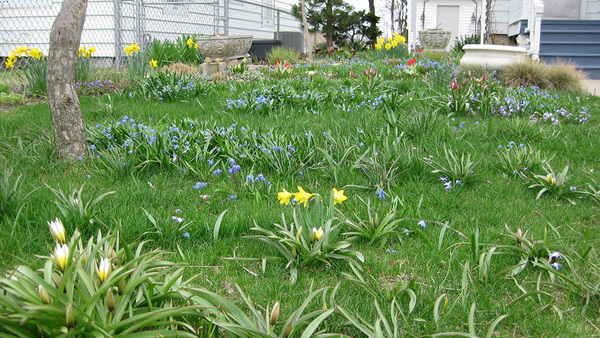
The vibrant offerings of bulb catalogs are entrancing as summer becomes a memory and autumn cold creeps in. We’re already full of gardening ideas for the spring season ahead. Bulbs are affordable, oh-so-easy to plant, and offer the jewel-like tones we know we’ll be craving next spring. Bulb selections shine brighter when refined with appropriate knowledge of timing, combinations, and perennial plant partners to create a gorgeous garden setting. Consider these tips to maximize the longevity and effect of your spring bulb purchases.

Don’t forget minor bulbs
Here in Wisconsin, the smaller, earlier blooming bulbs easily withstand early spring weather vagaries like frost and snow. However, if unseasonably warm days appear in May, I’m often disappointed when the later blooming varieties of tulips (Tulipa spp. and cvs., Zones 3–9) and daffodils (Narcissus spp. and cvs., Zones 3–9) bloom out so quickly that they can barely be enjoyed. Plus, by late spring, many perennials are popping into bloom and pulling our eyes elsewhere. Get the biggest bang for your bulb buck by including plenty of early bulbs that bloom when the pops of color are most needed and cooler temperatures extend bloom life. In Zone 5, minor bulbs like netted reticulated iris (Iris reticulata, Zones 5–9), snowdrops (Galanthus nivalus, Zones 3–7), and glory-of-the-snow (Chionodoxa spp. and cvs., Zones 3–8) can bloom starting in March and naturalize well for increasingly lovely displays into the future.

Explore the diversity of timing and form for daffodils and tulips
Pay close attention to the listed bloom times and sizes of your bulbs, and plan for a progression of color. Start with early blooming, shorter varieties, and transition into later blooming, taller varieties whose flowers will float above the shorter ones as they fade. Contrast in flower forms adds interest too. I like short, early cyclamineus daffodils (Narcissus cyclamineus, Zones 4–8)—with their cute, refracted petals—to build excitement in April. The tall, elegant forms of lily-flowered tulips can provide structure as bulb vignettes wind down in late May. Pump up your bulb display with lot of petals; try using superfull peony-flowering tulips for a romantic touch or bouquet-flowering tulips, which provide six to ten smaller flowers from just one bulb.

Look for perennial plant partners
When it comes to blooming year after year, not all bulbs are created equal, so look for “naturalizing” varieties that are likely to survive and increase over the long term. For bulbs to prosper into the future, it’s very important to leave their foliage intact until the bulb has gone completely dormant and restocked its energy for next year. Dried-up foliage should only be removed when it pulls out of the ground with no resistance. When siting bulbs, consider which perennial companions will serve as a fitting backdrop to the blooms and then mask declining bulb foliage. Early emerging mounded or ground-cover perennials are good partners; my favorites include ‘Orion’ geranium (Geranium ‘Orion’, Zones 5–8), any of the Cocktail™ Series geum (Geum cvs., Zones 5–8), and ‘Summer Beauty’ allium (Allium ‘Summer Beauty’, Zones 4–9). Grassy plants like sedges (Carex spp. and cvs., Zones 3–10), and cool season grasses like tufted hairgrass (Deschampsia caespitosa, Zones 3–8) and autumn moor grass (Sesleria autumnalis, Zones 5–8) are fantastic companions as well.
The breath of spring and riot of color that spring bulbs provide after a dreary Midwestern winter is a precious thing. A little extra thought in the fall ensures that these jewels have the setting they need for breathtaking and long-lasting effects in the garden.
Erin Presley is a horticulturist at Olbrich Botanical Gardens in Madison, Wisconsin.
Fine Gardening Recommended Products

Lee Valley Garden Knife
Fine Gardening receives a commission for items purchased through links on this site, including Amazon Associates and other affiliate advertising programs.

Gardener's Supply Company Summerweight Fabric Plant Cover
Fine Gardening receives a commission for items purchased through links on this site, including Amazon Associates and other affiliate advertising programs.

Lee Valley Mini Garden Shear Set
Fine Gardening receives a commission for items purchased through links on this site, including Amazon Associates and other affiliate advertising programs.



















Comments
Log in or create an account to post a comment.
Sign up Log in